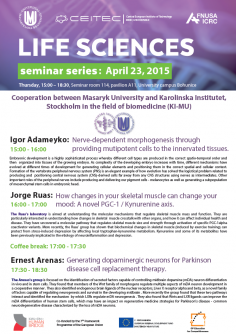Confirmed lectures:
- Igor Adameyko, Department of Physiology and Pharmacology, Karolinska Institutet, Sweden
Nerve-dependent morphogenesis through providing mutipotent cells to the innervated tissues.
Embryonic development is a highly sophisticated process whereby different cell types are produced in the correct spatio-temporal order and then organized into tissues of the growing embryo. As complexity of the developing embryo increases with time, different mechanisms have evolved at different times of development for generating cellular elements and positioning them in the correct spatial and cellular context. Formation of the vertebrate peripheral nervous system (PNS) is an elegant example of how evolution has solved the logistical problem related to producing and positioning central nervous system (CNS)-derived cells far away from any CNS structures using nerves as intermediates. Other important roles of the peripheral nerves include producing and delivering our pigment cells - melanocytes as well as generating a subpopulation of mesenchymal stem cells in embryonic head.
- Jorge Ruas, Department of Physiology and Pharmacology, Karolinska Institutet, Sweden
How changes in your skeletal muscle can change your mood: A novel PGC-1 / Kynurenine axis
The Ruas's laboratory is aimed at understanding the molecular mechanisms that regulate skeletal muscle mass and function. They are particularly interested in understanding how changes in skeletal muscle crosstalk with other organs, and how it can affect individual health and disease. They have uncovered a molecular pathway that regulates skeletal muscle size and strength through activation of specific PGC-1alpha coactivator variants. More recently, the Ruas' group has shown that biochemical changes in skeletal muscle (induced by exercise training) can protect from stress-induced depression by affecting local tryptophan-kynurenine metabolism. Kynurenine and some of its metabolites have been previously implicated in the etiology of neuroinflammation and depression.
- Ernest Arenas, Department of Medical Biochemistry and Biophysics, Karolinska Institutet, Sweden
Generating dopaminergic neurons for Parkinson disease cell replacement therapy
The Arenas's group is focused on the identification of secreted factors capable of controlling midbrain dopamine (mDA) neuron differentiation in vivo and in stem cells. They found that members of the Wnt family of morphogens regulate multiple aspects of mDA neuron development in a cooperative manner . They also identified endogenous brain ligands of the nuclear receptors, Liver X receptor alpha and beta, as a novel family of factors capable of regulating neurogenesis and survival in the developing midbrain. More recently the group found that these two pathways interact and identified the mechanism by which LXRs regulate mDA neurogenesis. They also found that Wnts and LXR ligands can improve the mDA differentiation of human stem cells, which may have an impact on regenerative medicine strategies for Parkinson’s disease - common neurodegenerative disease characterized by the loss of mDA neurons.








